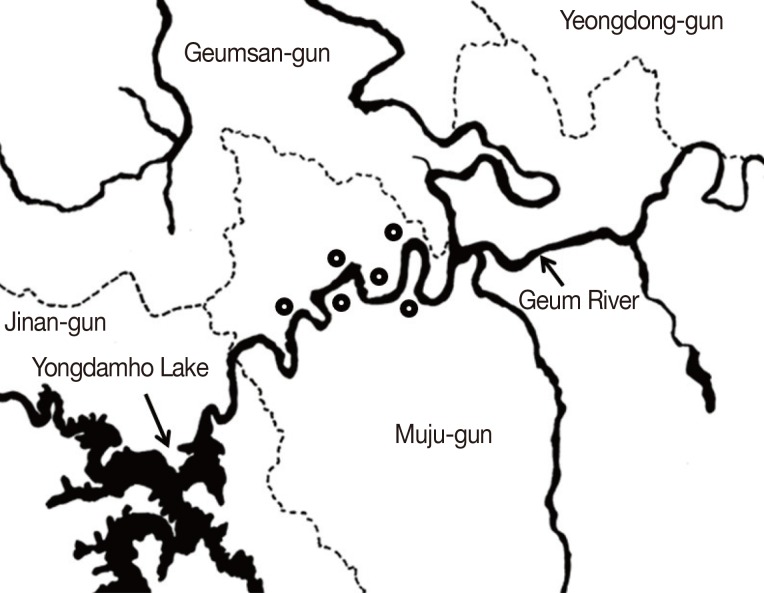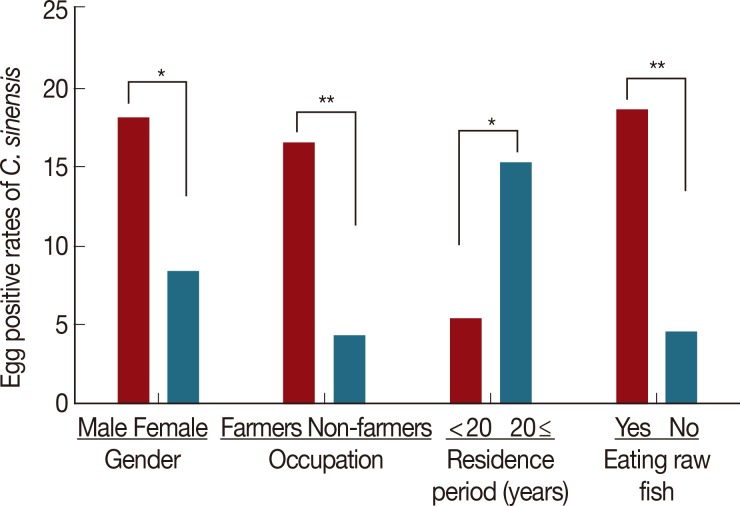1. Kim TS, Cho SH, Huh S, Kong Y, Sohn WM, Hwang SS, Chai JY, Lee SH, Park YK, Oh DK, Lee JK. Working Groups in National Institute of Health. Korea Association of Health Promotion. A nationwide survey on the prevalence of intestinal parasitic infections in the Republic of Korea, 2004.
Korean J Parasitol 2009;47:37-47.



2. Korea Centers for Disease Control and Prevention. Korea National Institute of Health. National survey of the prevalence of intestinal parasitic infections in Korea, 2012. The 8th Report. Osong Chungcheongbuk-do, Korea. 2013.
3. Lee GS, Cho IS, Lee YH, Noh HJ, Shin DW, Lee SG, Lee TY. Epidemiological study of clonorchiasis and metagonimiasis along the Geum-gang (River) in Okcheon-gun (county), Korea.
Korean J Parasitol 2002;40:9-16.



4. June KJ, Cho SH, Lee WJ, Kim C, Park KS. Prevalence and risk factors of clonorchiasis among the populations served by primary healthcare posts along five major rivers in South Korea.
Osong Public Health Res Perspect 2013;4:21-26.



5. Kim HK, Cheun HI, Cheun BS, Lee KY, Kim TS, Lee SE, Lee WJ, Cho SH. Prevalence of
Clonorchis sinensis infections along the five major rivers in Republic of Korea, 2007.
Osong Public Health Res Perspect 2010;1:43-49.



6. Cho SH, Lee KY, Lee BC, Cho PY, Cheun HI, Hong ST, Sohn WM, Kim TS. Prevalence of clonorchiasis in southern endemic areas of Korea in 2006.
Korean J Parasitol 2008;46:133-137.



7. Hong ST, Fang Y.
Clonorchis sinensis and clonorchiasis, an update.
Parasitol Int 2012;61:17-24.


8. Dang TC, Yajima A, Nguyen VK, Montresor A. Prevalence, intensity and risk factors for clonorchiasis and possible use of questionnaires to detect individuals at risk in northern Vietnam.
Trans R Soc Trop Med Hyg 2008;102:1263-1268.


9. Qian MB, Chen YD, Fang YY, Tan T, Zhu TJ, Zhou CH, Wang GF, Xu LQ, Zhou XN. Epidemiological profile of
Clonorchis sinensis infection in one community, Guangdong, People's Republic of China.
Parasit Vectors 2013;6:194.



10. Cho SH, Sohn WM, Na BK, Kim TS, Kong Y, Eom K, Seok WS, Lee T. Prevalence of
Clonorchis sinensis metacercariae in freshwater fish from three latitudinal regions of the Korean Peninsula.
Korean J Parasitol 2011;49:385-398.



11. Bouvard B, Baan R, Straif K, Grosse Y, Secretan B, El Ghissassi F, Benbrahim-Tallaa L, Guha N, Freeman C, Galichet L, Cogliano V. WHO International Agency for Research on Cancer Monograph Working Group. A review of human carcinogens. Part B: biological agents.
Lancet Oncol 2009;10:321-322.


12. Choi MH, Chang YS, Lim MK, Bae YM, Hong ST, Oh JK, Yun EH, Bae MJ, Kwon HS, Lee SM, Park HW, Min KU, Kim YY, Cho SH.
Clonorchis sinensis infection is positively associated with atopy in endemic area.
Clin Exp Allergy 2011;41:697-705.


13. Kim CH, Na YE, Kim NM, Shin DW, Chang DY. Intestinal parasite and
Clonorchis sinensis infection among the inhabitants in the upper stream of Taechong Dam, Kumgang (River).
Korean J Parasitol 1994;32:207-214.


14. June KJ, Park JY, Park DS, Jho KN, Jho JS, Kim SC, Suk ES, Shin DS, Lee EK, Kim ON. Prevalence of clonorchiasis, knowledge and intention to change behavior of village people living in the catchment area of community health posts along the Geum River. J Korean Acad Rural Health Nurs 2009;4:5-12.
15. Park DS. Current status of Clonorchis sinensis infection and its related factors among the residents of rural communities. J Korean Acad Rural Health Nurs 2007;2:33-42.
16. Seo BS, Lee SH, Cho SY, Chai JY, Hong ST, Han IS, Sohn JS, Cho BH, Ahn SR, Lee SK, Chung SC, Kang KS, Shim HS, Hwang IS. An epidemiologic study of clonorchiasis and metagonimiasis in riverside areas In Korea.
Korean J Parasitol 1981;19:137-150.


17. Park MD, Shin JH, Sohn SJ, Park J, Kim SI.
Clonorchis sinensis intervention at a Sumjin riverside area.
J Agric Med Community Health 2009;34:135-142.

18. Garcia LS. Diagnostic Medical Parasitology. 5th ed. Washington DC, USA. ASM Press. 2007, pp 423-438.
19. Kaewkes S. Taxonomy and biology of liver flukes.
Acta Trop 2003;88:177-186.


20. Zhang R, Gao S, Geng Y, Huang D, Yu L, Zhang S, Cheng J, Fu Y. Epidemiological study on
Clonorchis sinensis infection in Shenzhen area of Zhujiang delta in China.
Parasitol Res 2007;101:179-183.


21. Choi BI, Han JK, Hong ST, Lee KH. Clonorchiasis and cholangiocarcinoma: etiologic relationship and imaging diagnosis.
Clin Microbiol Rev 2004;17:540-552.



22. Choi D, Lim JH, Lee KT, Lee JK, Choi SH, Heo JS. Cholangiocarcinoma and
Clonorchis sinensis infection: A case-control study in Korea.
J Hepatol 2006;44:1066-1073.


23. Shin HR, Oh JK, Lim MK, Shin A, Kong HJ, Jung KW, Won YJ, Park S, Park SJ, Hong ST. Descriptive epidemiology of cholangiocarcinoma and clonorchiasis in Korea.
J Korean Med Sci 2010;25:1011-1016.



24. Yajima A, Cong DT, Trung DD, Cam TD, Montresor A. Cost comparison of rapid questionnaire screening for individuals at risk of clonorchiasis in low- and high-prevalence communities in northern Vietnam.
Trans R Soc Trop Med Hyg 2009;103:447-451.




 ); survey areas in Muju-gun along the Geum River basin.
); survey areas in Muju-gun along the Geum River basin.
